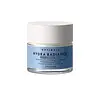What's inside
What's inside
 Key Ingredients
Key Ingredients

 Benefits
Benefits

 Concerns
Concerns

 Ingredients Side-by-side
Ingredients Side-by-side

Water
Skin ConditioningCaprylic/Capric Triglyceride
MaskingCetyl Alcohol
EmollientPropanediol
SolventStearyl Alcohol
EmollientGlycerin
HumectantSodium Hyaluronate
HumectantArginine
MaskingAspartic Acid
MaskingGlycine
BufferingAlanine
MaskingSerine
MaskingValine
MaskingIsoleucine
Skin ConditioningProline
Skin ConditioningThreonine
Histidine
HumectantPhenylalanine
MaskingGlucose
HumectantMaltose
MaskingFructose
HumectantTrehalose
HumectantSodium PCA
HumectantPCA
HumectantSodium Lactate
BufferingUrea
BufferingAllantoin
Skin ConditioningLinoleic Acid
CleansingOleic Acid
EmollientPhytosteryl Canola Glycerides
Skin ConditioningPalmitic Acid
EmollientStearic Acid
CleansingLecithin
EmollientTriolein
Skin ConditioningTocopherol
AntioxidantCarbomer
Emulsion StabilisingIsoceteth-20
EmulsifyingPolysorbate 60
EmulsifyingSodium Chloride
MaskingCitric Acid
BufferingTrisodium Ethylenediamine Disuccinate
Pentylene Glycol
Skin ConditioningTriethanolamine
BufferingSodium Hydroxide
BufferingPhenoxyethanol
PreservativeChlorphenesin
AntimicrobialWater, Caprylic/Capric Triglyceride, Cetyl Alcohol, Propanediol, Stearyl Alcohol, Glycerin, Sodium Hyaluronate, Arginine, Aspartic Acid, Glycine, Alanine, Serine, Valine, Isoleucine, Proline, Threonine, Histidine, Phenylalanine, Glucose, Maltose, Fructose, Trehalose, Sodium PCA, PCA, Sodium Lactate, Urea, Allantoin, Linoleic Acid, Oleic Acid, Phytosteryl Canola Glycerides, Palmitic Acid, Stearic Acid, Lecithin, Triolein, Tocopherol, Carbomer, Isoceteth-20, Polysorbate 60, Sodium Chloride, Citric Acid, Trisodium Ethylenediamine Disuccinate, Pentylene Glycol, Triethanolamine, Sodium Hydroxide, Phenoxyethanol, Chlorphenesin
Water
Skin ConditioningGlycerin
HumectantHydrogenated Polydecene
EmollientAluminum Starch Octenylsuccinate
AbsorbentBetaine
HumectantTriethylhexanoin
MaskingCyclopentasiloxane
EmollientCyclohexasiloxane
EmollientButyrospermum Parkii Butter
Skin ConditioningCetyl Alcohol
EmollientGlyceryl Stearate
EmollientPEG-100 Stearate
Stearyl Alcohol
EmollientPhenoxyethanol
PreservativeAmmonium Acryloyldimethyltaurate/Vp Copolymer
Imidazolidinyl Urea
PreservativeCaprylyl Glycol
EmollientStearic Acid
CleansingPalmitic Acid
EmollientXanthan Gum
EmulsifyingNiacinamide
SmoothingSodium Starch Octenylsuccinate
AbsorbentCalcium Pantothenate
Maltodextrin
AbsorbentBiosaccharide Gum-4
Skin ConditioningCalluna Vulgaris Flower Extract
Skin ConditioningCastanea Sativa Seed Extract
Skin ConditioningSodium Ascorbyl Phosphate
AntioxidantArachidic Acid
CleansingLauric Acid
CleansingMyristic Acid
CleansingPyridoxine Hcl
Skin ConditioningTocopheryl Acetate
AntioxidantPotassium Sorbate
PreservativeSodium Benzoate
MaskingSilica
AbrasiveWater, Glycerin, Hydrogenated Polydecene, Aluminum Starch Octenylsuccinate, Betaine, Triethylhexanoin, Cyclopentasiloxane, Cyclohexasiloxane, Butyrospermum Parkii Butter, Cetyl Alcohol, Glyceryl Stearate, PEG-100 Stearate, Stearyl Alcohol, Phenoxyethanol, Ammonium Acryloyldimethyltaurate/Vp Copolymer, Imidazolidinyl Urea, Caprylyl Glycol, Stearic Acid, Palmitic Acid, Xanthan Gum, Niacinamide, Sodium Starch Octenylsuccinate, Calcium Pantothenate, Maltodextrin, Biosaccharide Gum-4, Calluna Vulgaris Flower Extract, Castanea Sativa Seed Extract, Sodium Ascorbyl Phosphate, Arachidic Acid, Lauric Acid, Myristic Acid, Pyridoxine Hcl, Tocopheryl Acetate, Potassium Sorbate, Sodium Benzoate, Silica
 Reviews
Reviews

Ingredients Explained
These ingredients are found in both products.
Ingredients higher up in an ingredient list are typically present in a larger amount.
Cetyl Alcohol is a fatty alcohol. Fatty Alcohols are most often used as an emollient or to thicken a product.
Its main roles are:
Though it has "alcohol" in the name, it is not related to denatured alcohol or ethyl alcohol.
The FDA allows products labeled "alcohol-free" to have fatty alcohols.
Learn more about Cetyl AlcoholGlycerin is already naturally found in your skin. It helps moisturize and protect your skin.
A study from 2016 found glycerin to be more effective as a humectant than AHAs and hyaluronic acid.
As a humectant, it helps the skin stay hydrated by pulling moisture to your skin. The low molecular weight of glycerin allows it to pull moisture into the deeper layers of your skin.
Hydrated skin improves your skin barrier; Your skin barrier helps protect against irritants and bacteria.
Glycerin has also been found to have antimicrobial and antiviral properties. Due to these properties, glycerin is often used in wound and burn treatments.
In cosmetics, glycerin is usually derived from plants such as soybean or palm. However, it can also be sourced from animals, such as tallow or animal fat.
This ingredient is organic, colorless, odorless, and non-toxic.
Glycerin is the name for this ingredient in American English. British English uses Glycerol/Glycerine.
Learn more about GlycerinPalmitic Acid is a fatty acid naturally found in our skin and in many plant and animal sources. In cosmetics, it is usually derived from palm oil. It serves many purposes in skincare, acting as a cleanser, emollient, and emulsifier.
As an emollient, palmitic acid helps soften and smooth the skin by preventing water loss. In cleansers, it helps remove oil and dirt while creating foam.
Its emulsifying properties help stabilize products by keeping water and oil-based ingredients from separating.
This may not be suitable for fungal acne-prone skin, as fatty acids like this can sometimes trigger breakouts in sensitive individuals.
Learn more about Palmitic AcidPhenoxyethanol is a preservative that has germicide, antimicrobial, and aromatic properties. Studies show that phenoxyethanol can prevent microbial growth. By itself, it has a scent that is similar to that of a rose.
It's often used in formulations along with Caprylyl Glycol to preserve the shelf life of products.
Stearic Acid is a fatty acid. It is an emollient, emulsifier, and texture enhancer.
As an emollient, stearic acid helps soften skin. It aids the skin's protective barrier by preventing water loss. It also provides a gentle cleansing effect without stripping away natural oils.
Stearic acid may also be used to enhance the texture of products. It can add volume and stabilize ingredients such as water and oil. This can help water and oil ingredients from separating.
Sources of stearic acid include animal or vegetable fats/oils such as coconut or shea. It can be naturally found in butter, cocoa butter, shea butter, vegetable fats, and animal tallow.
This ingredient may not be Malassezia folliculitis, or fungal-acne safe.
Learn more about Stearic AcidStearyl Alcohol is a type of fatty alcohol from stearic acid. It is a white, waxy compound used to emulsify ingredients.
Fatty Alcohols are most often used as an emollient or to thicken a product. Emollients help soothe and hydrate the skin by trapping moisture.
They are usually derived from natural fats and oils and therefore do not have the same drying or irritating effect as solvent alcohols. FDA allows products labeled "alcohol-free" to have fatty alcohols.
Learn more about Stearyl AlcoholWater. It's the most common cosmetic ingredient of all. You'll usually see it at the top of ingredient lists, meaning that it makes up the largest part of the product.
So why is it so popular? Water most often acts as a solvent - this means that it helps dissolve other ingredients into the formulation.
You'll also recognize water as that liquid we all need to stay alive. If you see this, drink a glass of water. Stay hydrated!
Learn more about Water